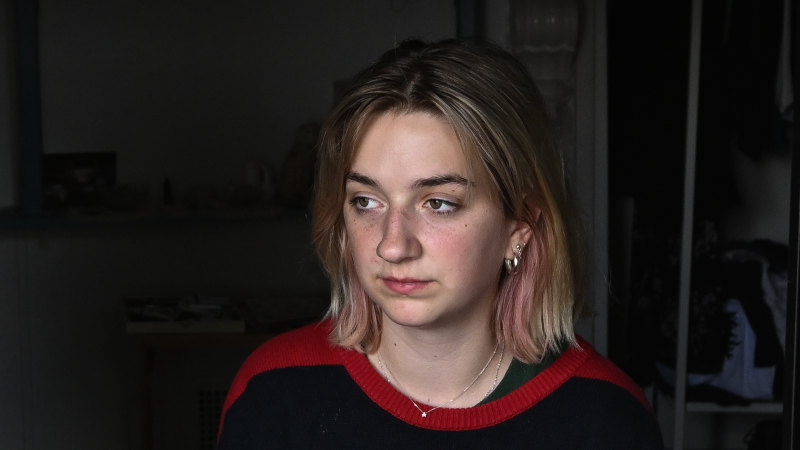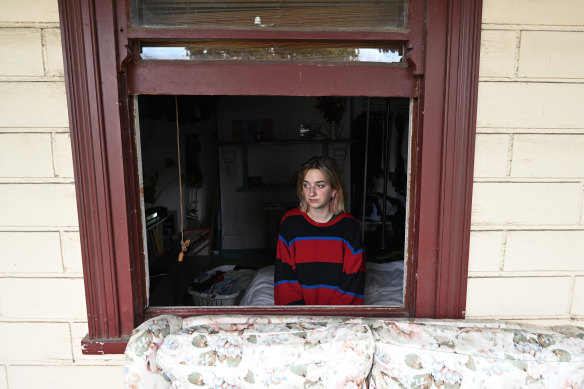For medical receptionist Bridget Rice-Finlayson, the appearance of double lines on her COVID Rapid Antigen Test on Wednesday morning was met with a familiar feeling of dread. This is her third time testing positive with COVID-19, and this time around she’s much better prepared.
“This time I know what’s going to happen, I feel pretty confident that I won’t get too sick,” said Rice-Finlayson.
Bridget Rice-Finlayson is isolating at home.Credit:Joe Armao
Rice-Finlayson remembers the horror of being evicted from her apartment by her housemate when she tested positive in Melbourne’s prolific 2020 lockdown.
“She decided she didn’t want me in the house with COVID. I was on the phone with DHS for hours trying to move somewhere else, eventually I got to move to my Auntie’s house,” she said.
While there are no longer any mandatory isolation requirements in place, she will still isolate at home for the recommended five days.
“Even though there’s no restrictions, you still feel like you shouldn’t do things because there’s a social obligation. You know people are judging you if you’re just going about your daily life as usual,” she said.
In mid-October Prime Minister Anthony Albanese dropped one of the longest-standing and last-remaining COVID restrictions: mandatory isolation if you tested positive for the virus.
Of course, Albanese himself is now in self-imposed isolation after he tested positive for COVID, delaying a meeting of national cabinet. The PM says he will continue to work from home.
Australia’s long lockdowns have slowly faded from the collective consciousness of the city. Social distancing, five-kilometre radiuses, empty playgrounds, and state border closures have become a distant memory for some.
With the nation released from the tight grip of pandemic orders, compliance with health recommendations has become a matter of personal preference. The decision to end isolation effectively ended Australia’s ‘pandemic exceptionalism’. COVID-19 is now treated like other respiratory viruses like the flu. There’s no legal requirement to isolate.
That said, there’s still a strong social expectation.
“It’s not for the general public: it’s for the vulnerable person with a major medical issue. You don’t know everyone’s medical history,” said University of Sydney infectious diseases paediatrician Professor Robert Booy. “You don’t know what their story is, you don’t know what their history is, and you could expose them unnecessarily.”
Isolation periods are designed to trap the virus so it can’t jump away and infect someone else. Generally, said Booy, you’re infectious a few days before you show symptoms – nothing much you can do about that – and then for another five days after the coughing starts.
That makes five days a pretty good length of time to isolate for, said Booy.
“Then you’re guided by your symptoms: if they are gone, you are less likely to be infectious. Five days would see most people no longer infectious.”
Some people might still have symptoms after the five days is up, and they may still be infectious, as everyone’s body and immune system is different. A small study of 55 people infected with Omicron, published in Clinical Microbiology and Infection in July, found more than 10 per cent were still shedding the virus 10 days after they were infected.
The Victorian government advises people with a runny nose, sore throat or cough to continue to isolate until their symptoms pass.
“There’s a bit of judgment involved,” said Booy. Are the symptoms caused by the virus, or do you know you often have an asthmatic cough after a virus passes? If it’s the latter, you might judge yourself OK to return to normal life.
After two stressful periods of COVID isolation, Rice-Finlayson is pleased about the new relaxed rules.
“A few of my friends have COVID so I’m probably going to hang out with them,” she said.
Make the most of your health, relationships, fitness and nutrition with our Live Well newsletter. Get it in your inbox every Monday.
Most Viewed in Lifestyle
From our partners
Source: Read Full Article

